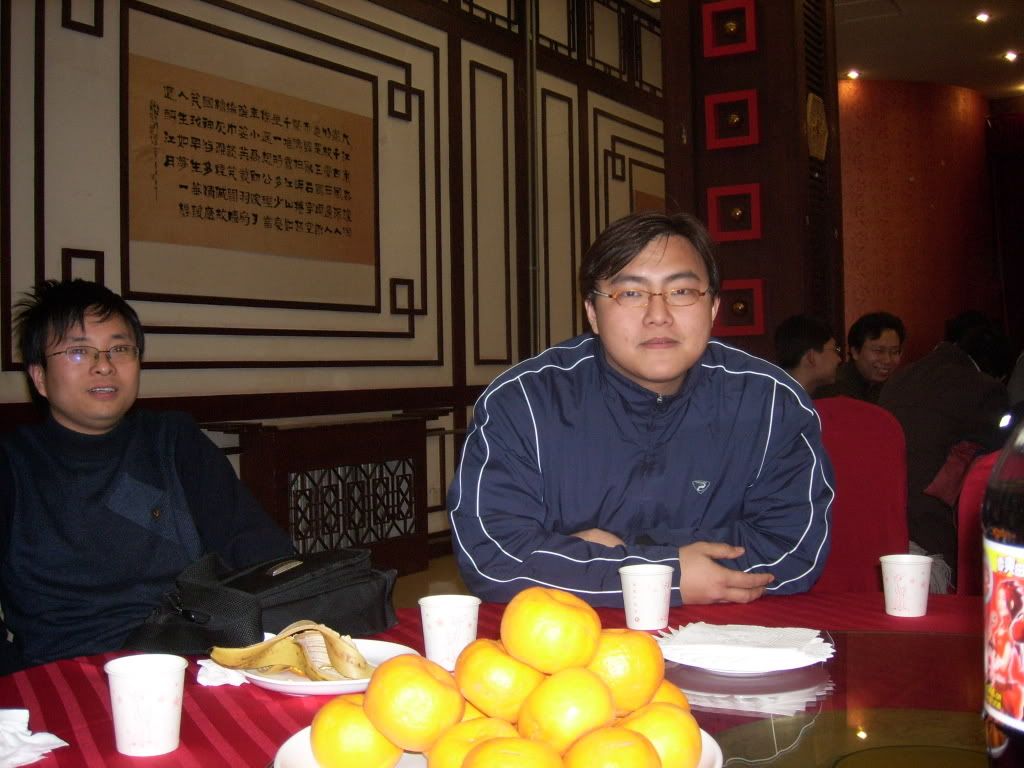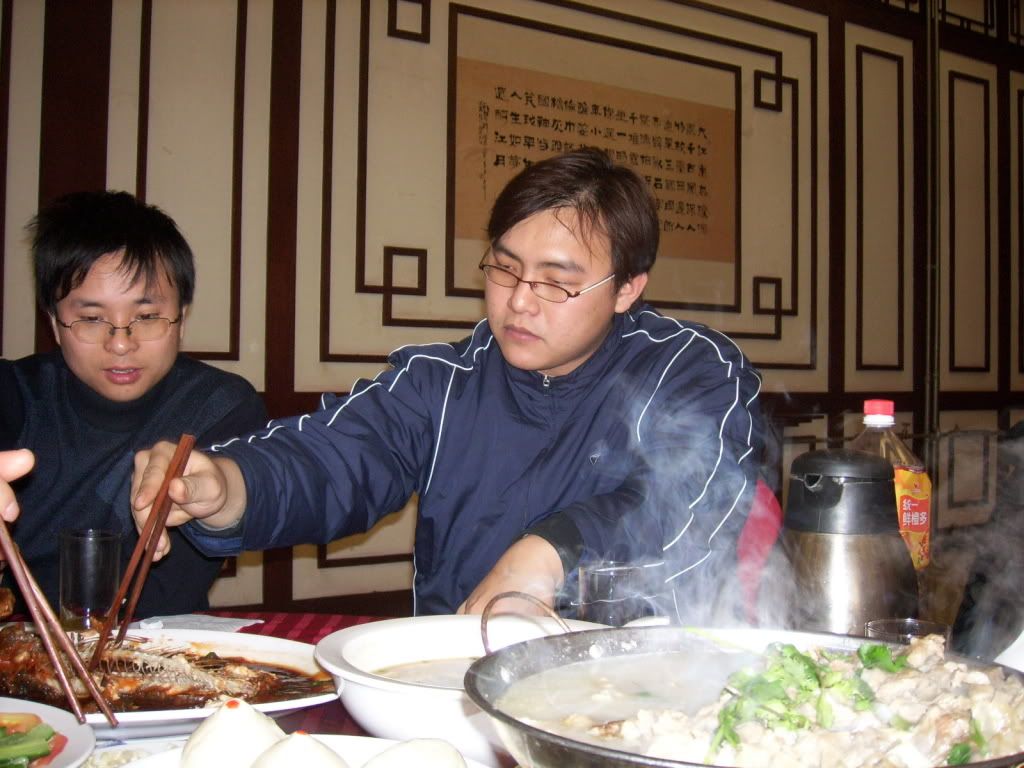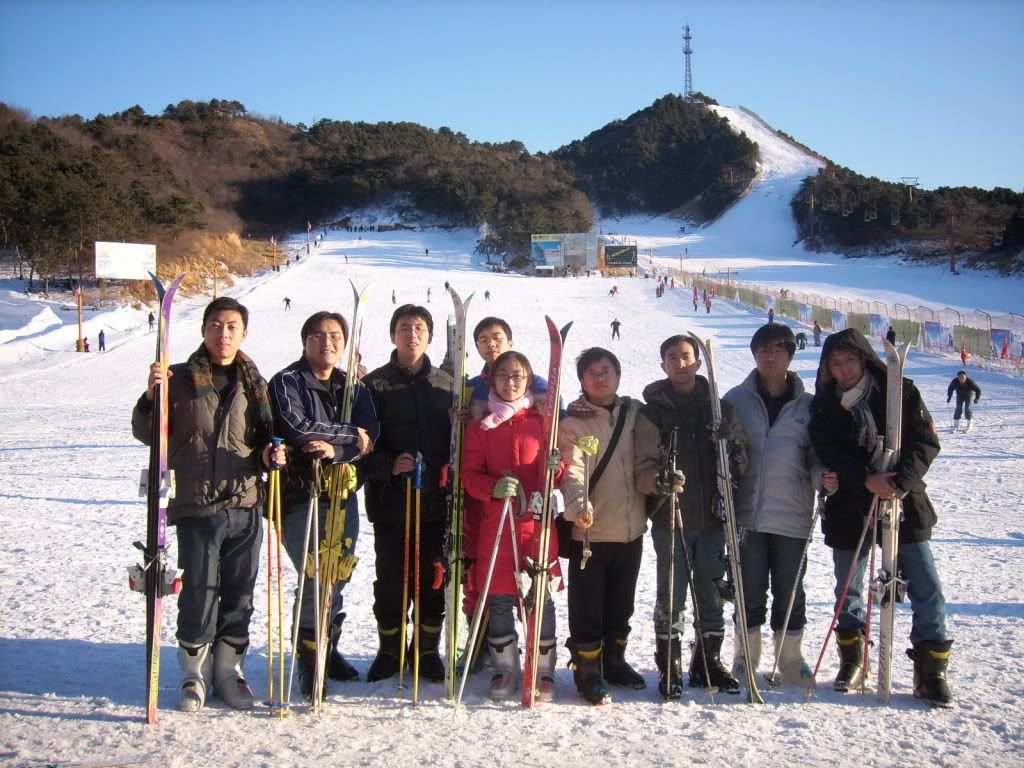Wednesday, October 10, 2007
What happens when a squash ball hits you?
Tuesday, September 25, 2007
Happy Mid-Autumn Festival!
To those who reads my seldom updated blog,
I will like to wish you a
Happy Mid-Autumn Festival!
中秋节快乐!
Origin of Mid-Autumn
The custom of celebrating the
The practice became very prevalent in the Tang Dynasty (618-907 CE) that people enjoyed and worshipped the full moon. In the Southern Song Dynasty (1127-1279), however, people started making round moon cakes, as gifts to their relatives in expression of their best wishes of family reunion. At night, they came out to watch the full moon to celebrate the festival. Since the Ming (1368-1644), and Qing Dynasties (1644-1911), the custom of Mid-Autumn Festival celebration has become unprecedentedly popular.
Some Stories related to Mid-Autumn : Overthrow of Mongol rule
According to a widespread folk tale (not necessarily supported by historical records), the Mid-Autumn Festival commemorates an uprising in China against the Mongol rulers of the Yuan Dynasty (1280–1368) in the 14th century. As group gatherings were banned, it was impossible to make plans for a rebellion. Noting that the Mongols did not eat mooncakes, Liu Bowen (劉伯溫) of Zhejiang Province, advisor to the Chinese rebel leader Zhu Yuanzhang, came up with the idea of timing the rebellion to coincide with the Mid-Autumn Festival. He sought permission to distribute thousands of moon cakes to the Chinese residents in the city to bless the longevity of the Mongol emperor. Inside each cake, however, was inserted a piece of paper with the message: "Kill the Tatars on the 15th day of the Eighth Moon" (八月十五殺韃子).On the night of the Moon Festival, the rebels successfully attacked and overthrew the government. What followed was the establishment of the Ming Dynasty (1368-1644), under Zhu. Henceforth, the Mid-Autumn Festival was celebrated with moon cakes on a national level.
Taken From: Wikipedia
Saturday, September 08, 2007
IN S'PORE: VICTIMS OF LOTTERY SCAMS DOUBLE IN NUMBER
------------------------------------------------------------------------------------
Teen who lost $3,800 admits own folly in believing conman's promises
By Crystal Chan
September 07, 2007
SHE was irked by the pop-up windows that kept appearing when she logged into a social networking website, prompting her to take part in a survey.
Miss H T Ng, who lost $3,800 in a lottery scam, said she was aware that others had lost money in similar ways.
Fed up, Miss H T Ng, 19, a student, did so on 9 Aug, hoping to stop the nuisance.
However, the personal information she gave pulled her into a lottery scam, costing her to lose $3,800.
Police figures show that a rising number ofpeople like Miss Ng have fallen for lotteryscams.
For the first eight months this year, the police have received 83 reports from victims who lost amounts ranging from $6 to $353,000 in such scams.
This is almost double the 42 reports made about such scams last year.
The police warns the public to be on guard as legitimate lottery companies do not ask for upfront payments before paying winners.
Its message is, 'If something is too good to be true, it probably is.'
Miss Ng is one of the youngest victims of such scams.
OVERSEAS CALL
She had included her real name and phone number in the survey and received anoverseas call on her handphone a few dayslater.
'The caller spoke with a Chinese accent,' she said. 'She told me I had won $200,000 after taking part in the survey and that the lucky draw had been held in HongKong.'
Thinking she would have to go to HongKong to claim the prize, Miss Ng said she was not interested and hungup.
Miss Ng said she had heard of people being conned in lottery scams and was suspicious.
But the woman, who claimed to be from a company called Huipu-C, phoned her again twohours later.
Miss Ng said: 'She persuaded me to claim the money, saying it was a big amount and that other winners had claimed theirs.
'She also gave me the company's website address, assuring me the whole thing wasn't ascam.'
Miss Ng got her mother, who was more fluent in Mandarin, to take another call from the woman the next day and her mother decided she should claim the $200,000.
But first, they had to pay $3,800 as an insurance deposit for 'taxpurposes'.
Miss Ng figured the prize would come in handy for her future studies, and did as told on 18 Aug, sending the money through Western Union, a remittancefirm.
CALLED AGAIN
However, instead of collecting the prize as expected the next day, she got another call to send another $4,500.
That was when she realised she had been conned.
She said: 'This time, a man claiming to be a manager at the Hong Kong Turf Club said I couldn't get my prize because I wasn't a club member.
'He said I was contacted because of a technical error. He also said I had to pay more money to get the prize.'
By then, Miss Ng knew she had lost the money she sent earlier, saved from working as a part-time sales promoter for more than ayear.
She said: 'I didn't want to lose any more money. I already felt so much heartache at losing the $3,800.'
She made a police report immediately after hanging up, but by then, the crooks had withdrawn the money.
She said she still feels 'sore' about losing the money and said it was greed and naivety that caused her to fall for the scam.
Taken From the Electric New Paper
Friday, September 07, 2007
When Piracy Becomes Promotion
By Henry Jenkins
Anime is everywhere. The global sales of Japanese animation and character goods, an astonishing 9 trillion yen ($80 billion) has grown to 10 times what it was a decade ago. In his 2003 opening speech to the Japanese Diet, Prime Minister Junichiro Koizumi praised Spirited Away (the first non-American release to win the Academy Award for best animated feature) and anime more generally as the savior of Japanese culture.
Much of that growth has occurred in North America and Western Europe, where young people have embraced this distinctive style of popular culture, one which extends well beyond the wide-eyed beauties, cute animals, and giant robot battles anime represents for the most casual consumers.
Disney has purchased the American rights to Spirited Away and the other films of its creator Hayao Miyazaki (Princess Mononoke, Kikis Delivery Service), redubbing these films with the voices of American film stars. The Cartoon Network features a wide array of anime series as part of its late night Adult Swim programming. ADV Films, a major importer of anime series for the American market, has launched a 24 hours Anime Network. TOKYOPOP, a Los Angeles-based company, will publish 400 volumes of translated manga (Japanese comics) for U.S. consumption this year. One can find whole shelves of manga in many Barnes and Noble or Borders bookstores, where they frequently outsell American-produced graphic novels.
Japanese anime has won worldwide success in part because Japanese media companies were tolerant of the kinds of grassroots activities that American media companies seem so determined to shut down. Much of the risks of entering Western markets and many of the costs of experimentation and promotion were born by dedicated consumers. A symbiotic relationship existed between fans and producers that warrants closer consideration as we watch American media companies take a scorched earth attitude toward their most dedicated followers.
Two decades ago, the U.S. market was totally shut to these Japanese imports. Today, the sky is the limit, with many of the most successful childrens series, from Pokemon to Yu-Gi-Oh!, coming directly from Japanese production houses. The shift occurred not through some concerted push by Japanese media companies, but rather in response to the pull of American fans who used every technology at their disposal to expand the community that knew and loved this content. Subsequent commercial efforts built on the infrastructure these fans developed over the intervening years. In this essay, I am drawing heavily on a detailed chronicle of the early history of American anime fandom developed by the former President of the MIT Anime Club, Sean Leonard.
Japanese animation was exported into the western market as early as the 1960s, when Astro Boy, Speed Racer, and Gigantor made it onto American television primarily through local syndication. By the late 1960s, however, reform efforts, such as Action for Childrens Television, had used threats of boycott and federal regulation to push back against content they saw as inappropriate for American children. The next wave of Japanese content aimed at adults in its country of origin, often dealt with more mature themes and was a particular target of the backlash. Discouraged Japanese distributors retreated from the U.S. market, dumping their cartoons on Japanese language cable channels in cities with large Asian populations.
The rise of videotape recorders significantly changed this picture. American fans could dub shows off the Japanese language channels and share them with their friends in other regions. Soon, fans were seeking contacts in Japan‑both local youth and American G.I.s with access to newer series. Both Japan and the United States used the same NTSC video format, easing the flow of content across national borders. American fan clubs emerged to support the archiving and circulation of Japanese animation. The clubs, such as the MIT Anime Club, functioned as lending libraries and dubbing centers as well as holding marathon screenings to attract new members.
In most cases, the content was shown without translation. I remember attending some screenings in the late 1970s. Much like attending an opera, someone would stand up and tell us the plot and then we would watch without understanding anything said. We didnt know what we were watching but it was pretty damned interesting any way.
Japanese distributors winked at these screenings. They didnt have permission from their mother companies to charge these fans or provide the material but they were interested to see how much interest the shows attracted.
The late 1980s and early 1990s saw the emergence of fansubbing, the amateur translation and subtitling of Japanese anime. What enabled such efforts was the introduction of a devicecalled a genlock, for generator lockingthat allowed a television set to accept two signals simultaneously and that synchronized an incoming video signal with computer output. Time-synchronized VHS and S-VHS systems made it possible to dub the tapes so that they retained accurate alignment of text and image. The high costs of the earliest machines meant that fansubbing would remain a collective effort: clubs pooled time and resources to insure their favorite series reached a wider viewership. As costs lowered, fansubbing spread outward, with clubs using the Internet to coordinate their activities, divvying up what series to sub and tapping a broader community for would-be translators.
Beginning in the early 1990s, large-scale anime conventions brought artists and distributors from Japan, who were astonished to see a thriving culture surrounding content they had never actually marketed here and who went back home motivated to try to commercially tap this interest. Some key players in the Japanese animation industry had been among those who had aided and abetted U.S. grassroots distribution a decade earlier.
The first niche companies to distribute Anime on DVD and videotape emerged as fan clubs simply went pro, acquiring the distribution rights from re-engaged Japanese media companies. The first material to be distributed already had an enthusiastic fan following. Interested in exposing their members to the full range of content available in Japan, the fan clubs had often taken risks that no commercial distributor would have confronted, testing the market for new genres, producers, and series and commercial companies followed their path where-ever they found popularity.
The fansubbed videos often ran an advisory urging users to cease distribution when licensed. The clubs were not trying to profit from anime distribution but rather to expand the market; they pulled back from circulating any title that had found a commercial distributor. In any case, the commercial copies were higher quality than their multi-generation dubs.
The first commercially available copies were often dubbed and re-edited as part of an effort to expand their potential interest to casual consumers. Japanese cultural critic Koichi Iwabuchi used the term, deodorizing, to refer to the ways that Japanese soft goods are stripped of signs of their national origins to open them for global circulation. Anime and manga now rank at the top of these cultural exports. In Japan, manga constitute 40 percent of all books and magazines published and more than half of all movie tickets sold are to animated films. More than 200 animation programs are aired each week on Japanese television and about 1700 animated films (short or feature length) are produced for theatrical or straight-to-video distribution each year. Japanese media producers had created a complex set of tie-ins between comics, animated films, television series, toys, and games that allowed them to capitalize quickly on successful content. They are increasingly eager to export this whole apparatus internationally. In this context, the grassroots fan community still plays an important role, helping to educate American viewers to the cultural references and genre traditions defining these products through their websites and newsletters. The fan clubs continue to explore potential niche products that over time can emerge as mainstream successes.
Many U.S. media companies might have regarded all of this underground circulation as piracy and shut it down before it reached critical mass. The Japanese media companys tolerance of these fan efforts is consistent with their similar treatment of fan communities in their local market. As Temple University law professor Salil K. Mehra notes, the underground sale of fan-made manga, often highly derivative of the commercial product, occurs on a massive scale in Japan, with some comics markets attracting 150,000 visitors per day; such markets are held almost every week in some parts of the country. Rarely taking legal action, the commercial producers sponsor such events, using them to publicize their releases, to recruit potential new talent, and to monitor shifts in audience tastes. In any case, they fear the wrath of their consumers if they took action against such a well-entrenched cultural practice and the Japanese legal structure would provide for fairly small legal penalties if they did pursue infringers.
More generally, as Yuichi Washida, a research director at Hakuhodo, Japans second largest advertising and marketing firm, has argued, Japanese corporations have sought to collaborate with fan clubs, subcultures, and other consumption communities, seeing them as important allies in developing compelling new content or broadening markets. In courting such fans, the companies helped to construct a moral economy that aligned their interests in reaching a market with the American fans desires to access more content.
Many have argued that cultural rather than legal, technological, or economic solutions are crucial in resolving the bootlegging crisis hitting American media companies. Rather than suing their fan base, perhaps they should study how their Japanese counterparts profited from this first wave of underground circulation, seeing it as promotion rather than piracy.
Copyright Technology Review 2004.
Tuesday, August 28, 2007
Friday, August 24, 2007
Extreme Diet Coke & Mentos Experiments
Extreme Diet Coke & Mentos Experiments II: The Domino Effect
Thursday, August 23, 2007
Why Transformers Cannot Be Set in Singapore
NATIONAL DAY SPECIAL: 60 SIGNS YOU’RE A TRUE SINGAPOREAN

It’s not enough if you pay taxes or carry a pink IC. To commemorate National Day, TalkingCock.com brings you a checklist to see how Singaporean you really are.
1. Thanks to SMS, you have an extra large thumb.
2. Tks 2 SMS, u oso dun no how 2 spel n e mor.
3. You pat MRT and bus seats to cool them before you sit down.
4. At lunch, you start discussing what to eat for dinner.
5. Your wedding photos include shots of you dressed up like Louis XIV, Michael Jackson, or Leonardo DiCaprio and Kate Winslet in Titanic.
6. When speaking to foreigners, you somehow feel a need to adopt an accent. (If you’re a DJ, this happens even when you’re not speaking to foreigners.)
7. You won’t raise your voice to protest policies, but you’ll raise your fists to whack someone over Hello Kitty.
8. You’re forever talking about businesses you want to set up but will probably never get around to starting.
9. You don’t know ¾ of the people attending your wedding.
10. You separate food into 2 basic groups: ‘heaty’ and ‘cooling’.
11. You’re never completely sure how many times you’ve sung the second verse of the National Anthem.
12. You think that what makes you ‘married’ is not the legal registration but whether you’ve thrown a 12 course dinner.
13. You marry for the real estate breaks.
14. You have kids for the tax advantages.
15. You move to where you want your child to go to school.
16. You feel you can’t walk around naked in your own flat.
17. You force your children to take Speech & Drama classes, but pray they won’t wind up in Arts later on.
18. You suddenly realize you’re very interested in biotech - just like you suddenly realized three years ago that you were very interested in e-commerce, and before that, engineering, and before that, medicine and law.
19. You think being an entrepreneur is setting up a bubble tea/Portuguese egg tart/gao luck/porridge shop right next to an existing bubble tea/Portuguese egg tart/gao luck/porridge shop.
20. You think people are inconsiderate when they don’t leave their table immediately after eating at the food court but think you have every right to take 25 bites to finish the last red bean in your ice kachang.
21. You find it impossible to make suggestions without drawing a fishbone chart first.
22. If you’re a guy, whenever you get together with your guy friends, you invariably trade army stories.
23. If you’re a girl, whenever you get together with your girl friends, you invariably trade stories about how your stupid guy friends are forever trading army stories.
24. You think the most important sporting event in Singapore this year was David Beckham switching from Manchester United to Real Madrid.
25. You somehow feel that food tastes better when eaten by a longkang.
26. It actually makes a difference to you being called an ‘NSMan’ rather than a ‘Reservist’.
27. You’ve eaten more times at the Esplanade than you’ve actually seen shows there.
28. You need campaigns to tell you how to be courteous, to flush toilets, have sex, etc.
29. When you visit the Zoo, you wonder what the animals taste like.
30. You feel the urge to add the suffix ‘-polis’ to everything, viz. Biopolis, Airtropolis, Fusionopolis, Entrepolis, etc.
31. You always feel oddly hungry at 11 pm, and are willing to drive to far away places for supper.
32. You meet in hotels a lot.
33. Your children have a rudimentary knowledge of Tagalog or Bahasa Indonesia.
34. You work at McDonald’s when you’re old rather than young.
35. You’ll gladly spend $50,000 on a car, but will go to great lengths to save a few bucks on ERP charges or even a few cents on a parking coupon.
36. Pork floss and mayonnaise on bread is a completely natural combination to you.
37. If you’re pregnant, you have the strange ability to make people on the MRT fall asleep instantly.
38. You ask for the bill by miming a signing movement.
39. You’ve started referring to foreign employees as ‘talent’ instead of ‘expatriates’.
40. At the dinner table, you’re always discussing which other food places serve better versions of what you’re eating.
41. You copy down licence plate numbers of cars involved in accidents.
42. You think your boyfriend doesn’t really love you unless he gives you part of his liver.
43. During sales, you book hotel rooms near malls to enable you to shop more efficiently.
44. You pronounce the letter ‘R’ as ‘ah-rer’ and the letter ‘H’ as ‘haytch’.
45. No matter how old you are, you keep associating people with their secondary schools. (alternative: No matter how old you are, you secretly need to know what other people got for their PSLE, O levels and A levels.)
46. You’re always on a quest for the definitive version of your favourite local dish.
47. When you explain things to people, you keep (a) using alphabets, and (b) speaking in point form.
48. You believe that you can generate ‘creativity’ through rules and committees.
49. You ‘chope’ a seat by placing a packet of tissues on the chair.
50. You’re very forthright with your criticisms of the Gahmen, unless there’s a chance they might actually hear you.
51. You diligently track the whereabouts of your favourite hawkers, i.e..you know that the famous Tiong Bahru Bao is now in Jurong, the famous Outram Char Kuay Teow is now in Hong Lim Centre and the famous Lau Hock Kien Hokkien mee from the old Lau Pa Sat is now at Beach Road.
52. Your mother probably can’t speak your ‘mother tongue’.
53. You’d rather drink your own pee than pay someone more for water.
54. You secretly find that the best part of the Speak Good English Movement is hearing the Singlish bits in their ads.
55. You have an automatic sensor in your head which categorizes people you meet into stayer/ quitter, cosmopolitan/heartlander, normal/ express/ gifted, etc.
56. You think we’re living in a modern, sophisticated country even when our leaders still insist on wearing their school uniforms.
57. You wish your constituency is in a walkover, because otherwise it’s damn ‘leceh’.
58. During elections, you decide that there is no credible opposition even though you don’t know the name of the opposition candidate in your constituency.
59. You think having a constitution is like the condition you get when you don’t eat enough fibre.
60. You can never quite remember what “the core values” of Singaporeans are.
by Kway Png
© http://www.TalkingCock.com 2001-2003. All rights reserved.
Wednesday, August 22, 2007
MOS Dusty Opening + SAFRA Night
Wednesday, August 08, 2007
Singapore Women's Masters Squash Championship, Singapore
Final:
Nicol David Masters Singapore In Latest Triumph
Nicol David showed fans in Singapore just why she is the world squash number one with a fine display that was full of running and crafty shot-making, outlasting her closest rival Natalie Grinham 9-6, 9-5, 9-5 in 54 minutes in the final to win the inaugural Women’s CIMB Singapore Masters at the Kallang Squash Centre in Singapore.
 03-Aug:
03-Aug:
Semi-Finals Results:
[1]Nicol David(Mas) vs [3]Rachael Grinham(Aus) 9/2, 9/2, 9/3 (23m)
[2]Natalie Grinham(Aus) vs [4]Tania Bailey(Eng) 9/6, 9/6, 9/1 (46m)
02-Aug:
Quarter-Finals Results:
[1]Nicol David(Mas) vs [5]Vicky Botwright(Eng) 10/8, 9/0, 9/3 (44m)
[3]Rachael Grinham(Aus) vs [6]Omneya Abdel Kawy(Egy) 5/9, 9/5, 9/0, 7/9, 9/4 (68m)
[4]Tania Bailey(Eng) vs [8]Jenny Duncalf(Eng) 8/10, 9/3, 3/9, 9/1, 9/1 (84m)
[2]Natalie Grinham(Aus) vs [7]Madeline Perry(Irl) 9/5, 9/5, 9/2 (38m)
Taken from : © World Squash Federation
I was there... hoping to witness the match on 04th Aug.... but I can only see the back right hand cornor of the court... kaoz.. there was too many people there... so horrifying... didn't know that there were so many squash fan in Singapore... :p
but I got to see all the full matches for the quater-final and semi-final on the 2nd and 3rd August... mmm... better than nothing... :p
Thursday, August 02, 2007
Licensed Anime (By AnimeSuki)
Licensed anime is any series or movie (part or whole) for which the rights to publish the anime in a specific area have been bought. Simply put, if a company buys the rights to put an anime series or movie on TV and/or release it on DVD in the USA (in English), that anime series or movie is considered licensed anime by AnimeSuki. Note that of course it's also possible for anime series and movies to be licensed in other areas (such as Europe). Such licenses usually involve publishing in languages other than English though and therefore are of no interest to us.
The original purpose of fansubs
As recent as about 10 to 15 years ago anime was not easy to get outside of Asia. The few anime companies that existed could only bring out a few titles as they lacked the funds and the market for licensing more shows. To get more anime and also to encourage certain titles to get licensed in the US, some anime fans started to make fansubs: series which were taped of Japanese television with subtitles added. These fansubs were distributed on VHS tape. One of the self imposed rules the fansub groups adapted was that once a series was licensed in the US, distribution of the fansub should stop. After all, the fansub had served it's purpose.
Eventually the popularity of anime grew in the US and with it the market for anime grew, which in turn resulted in more money to be available to license even more shows. It is probably this reason why in the past few years more and more shows are getting licensed. The popularity of fansubs also grew explosively with the introduction of digisubs: digital fansubs which could be easily distributed over the internet.
Fansubs violate copyrights
We have to admit it: the distribution of fansubs is technically a violation of copyright under the WTO TRIPS agreement. However the TRIPS agreement does not demand that distribution of copyrighted material is a criminal offence unless it is done on a commercial scale. This means it is up to the copyright holder to bring the offender to court. The copyright of unlicensed material is held by the original creator. In the case of anime this usually means the Japanese distribution company. If something is licenced, the licensee holds the copyright and thus the right to sue any copyright infringers within the area covered by the license. (source: ato's forum post)
Up until now fansub groups have had little to worry about legal pressure from Japan. However US companies are more likely to sue, therefore it is an additional reason for fansub groups to stop distributing a series once it gets licensed in the US.
The future of fansubs
Whether fansubs have a future remains to be seen. David Williams of ADV Films recently mentioned at Anime Boston 2003: "One thing fans might not know is most shows are licensed now during the financing stage, before the show is even produced. This makes a lot of fansubs pointless now. Of course, there are still old shows that probably won?t be licensed; but new shows are almost guaranteed."
Still some series might need some help to get popular. Would you buy Azumanga Daioh DVDs if you had have never heard about it? Fansubs probably helped this series and others gain popularity. Also as there is so much anime being created in Japan, there will usually always be some series which don't get licensed for some reason, like Boys Be or Kokoro Library.
It's not a perfect world
If you are wondering why you can still find fansubs of licensed shows (even of episodes aired after the show was licensed), the answer is that the world is not perfect. Certain fansub groups do not follow the general fansub ethics of ceasing the distribution and fansubbing of a show after it is licensed. AnimeSuki does not recommend downloading these files, but there is little we can do to stop them.
What if you're not in the US?
While a large part of the visitors of AnimeSuki are from the US and Canada, not all of them are of course. Those people might be thinking: "If anime is licensed in the US, what has that to do with me? Why stop fansubbing? Why remove it from AnimeSuki?". AnimeSuki's view on this is that the US is the largest market for English subbed and dubbed anime, therefore once anime is licensed in the US all English fansubbing of it should stop.
If you're not from the US, this means you can still download non-English fansubs of the same series (if it's not licensed in your region as well). Alternatively you could also import the DVDs when they are released in the US. It is not expensive to do so if you order directly from online DVD shops in the US. You will need a region free DVD player of course, but even those are easy to get - just ask around or check out The Firmware Page to make your DVD-ROM drive region free.
If a title is not licensed in your area and you still want to download English fansubs, AnimeSuki won't stop you from doing so. However, we won't help you find them either for reasons mentioned earlier. Also be aware that (again for obvious reasons) newer episodes of series which have been licensed before being completely fansubbed might be very hard to get. So even if AnimeSuki did not have the policy of removing licensed anime, we would still be left with very little to link to!
AnimeSuki.com & Fansubs
Unless something major happens, AnimeSuki.com will continue to list torrent links to the latest English fansubs of unlicensed anime. Please note however that only torrent links listed on AnimeSuki can safely be considered to be unlicensed. Certain BitTorrent sites also tend to list licensed anime, which AnimeSuki does not support. However it is not possible for us to just link to those torrents which are not licensed as we link to sites and not the torrent files directly.
See the License List for an overview of anime which AnimeSuki considers licensed.
Taken From : AnimeSuki
Monday, July 30, 2007
Saturday, July 28, 2007
Ethics and Virtue
For many of us, the fundamental question of ethics is, "What should I do?" or "How should I act?" Ethics is supposed to provide us with "moral principles" or universal rules that tell us what to do. Many people, for example, read passionate adherents of the moral principle of utilitarianism: "Everyone is obligated to do whatever will achieve the greatest good for the greatest number." Others are just as devoted to the basic principle of Immanuel Kant: "Everyone is obligated to act only in ways that respect the human dignity and moral rights of all persons."
Moral principles like these focus primarily on people's actions and doings. We "apply" them by asking what these principles require of us in particular circumstances, e.g., when considering whether to lie or to commit suicide. We also apply them when we ask what they require of us as professionals, e.g., lawyers, doctors, or business people, or what they require of our social policies and institutions. In the last decade, dozens of ethics centers and programs devoted to "business ethics", "legal ethics", "medical ethics", and "ethics in public policy" have sprung up. These centers are designed to examine the implications moral principles have for our lives.
But are moral principles all that ethics consists of? Critics have rightly claimed that this emphasis on moral principles smacks of a thoughtless and slavish worship of rules, as if the moral life was a matter of scrupulously checking our every action against a table of do's and don'ts. Fortunately, this obsession with principles and rules has been recently challenged by several ethicists who argue that the emphasis on principles ignores a fundamental component of ethics--virtue. These ethicists point our that by focusing on what people should do or how people should act, the "moral principles approach" neglects the more important issue--what people should be. In other words, the fundamental question of ethics is not "What should I do?" but "What kind of person should I be?"
According to "virtue ethics", there are certain ideals, such as excellence or dedication to the common good, toward which we should strive and which allow the full development of our humanity. These ideals are discovered through thoughtful reflection on what we as human beings have the potential to become.
"Virtues" are attitudes, dispositions, or character traits that enable us to be and to act in ways that develop this potential. They enable us to pursue the ideals we have adopted. Honesty, courage, compassion, generosity, fidelity, integrity, fairness, self-control, and prudence are all examples of virtues.
How does a person develop virtues? Virtues are developed through learning and through practice. As the ancient philosopher Aristotle suggested, a person can improve his or her character by practicing self-discipline, while a good character can be corrupted by repeated self-indulgence. Just as the ability to run a marathon develops through much training and practice, so too does our capacity to be fair, to be courageous, or to be compassionate.
Virtues are habits. That is, once they are acquired, they become characteristic of a person. For example, a person who has developed the virtue of generosity is often referred to as a generous person because he or she tends to be generous in all circumstances. Moreover, a person who has developed virtues will be naturally disposed to act in ways that are consistent with moral principles. The virtuous person is the ethical person.
At the heart of the virtue approach to ethics is the idea of "community". A person's character traits are not developed in isolation, but within and by the communities to which he or she belongs, including family, church, school, and other private and public associations. As people grow and mature, their personalities are deeply affected by the values that their communities prize, by the personality traits that their communities encourage, and by the role models that their communities put forth for imitation through traditional stories, fiction, movies, television, and so on. The virtue approach urges us to pay attention to the contours of our communities and the habits of character they encourage and instill.
The moral life, then, is not simply a matter of following moral rules and of learning to apply them to specific situations. The moral life is also a matter of trying to determine the kind of people we should be and of attending to the development of character within our communities and ourselves.
Taken from: Santa Clara University
Friday, July 27, 2007
Friendster Horoscope for July 27, 2007
The Bottom Line
The hard choices are behind you! Today, bask in the glow of a clear conscience.
In Detail
The difficult choices are behind you! Today you will be able to focus your energies on basking in the glow of a clear conscience. You have done what you were meant to do, and no more involvement on your part is required! If you have the time, this is a great day to strike off on your own into nature -- a short hike or a walk in the woods will do a wonderful job of centering you, getting your feet back on the ground, and preparing you for the opportunities that are waiting in the wings.
-----------------------
Wish me Luck !
:p
Monday, July 23, 2007
Personal Responsibility
But it always catches up…
I really hate this…
Should I stop down,
and take it running with me?
Maybe it is time…
Just a bit of time more… I will try…
I should face responsibility…
Content below is from : Tools for Coping with Life's Stressors
What is accepting personal responsibility?
Accepting personal responsibility includes:
- Acknowledging that you are solely responsible for the choices in your life.
- Accepting that you are responsible for what you choose to feel or think.
- Accepting that you choose the direction for your life.
- Accepting that you cannot blame others for the choices you have made.
- Tearing down the mask of defense or rationale for why others are responsible for who you are, what has happened to you, and what you are bound to become.
- The rational belief that you are responsible for determining who your are, and how your choices affect your life.
- Pointing the finger of responsibility back to yourself and away from others when you are discussing the consequences of your actions.
- Realizing that you determine your feelings about any events or actions addressed to you, no matter how negative they seem.
- Recognizing that you are your best cheerleader; it is not reasonable or healthy for you to depend on others to make you feel good about yourself.
- Recognizing that as you enter adulthood and maturity, you determine how your self-esteem will develop.
- Not feeling sorry for the "bum deal" you have been handed but taking hold of your life and giving it direction and reason.
- Letting go of your sense of over responsibility for others.
- Protecting and nurturing your health and emotional well being.
- Taking preventive health oriented steps of structuring your life with time management, stress management, confronting fears, and burnout prevention.
- Taking an honest inventory of your strengths, abilities, talents, virtues, and positive points.
- Developing positive, self-affirming, self-talk scripts to enhance your personal development and growth.
- Letting go of blame and anger toward those in your past who did the best they could, given the limitations of their knowledge, background, and awareness.
- Working out anger, hostility, pessimism, and depression over past hurts, pains, abuse, mistreatment, and misdirection.
How can failing to accept personal responsibility result in negative consequences?
When you have not accepted personal responsibility, you can run the risk of becoming:
- Overly dependent on others for recognition, approval, affirmation, and acceptance.
- Chronically hostile, angry, or depressed over how unfairly you have been or are being treated.
- Fearful about ever taking a risk or making a decision.
- Overwhelmed by disabling fears.
- Unsuccessful at the enterprises you take on in life.
- Unsuccessful in personal relationships.
- Emotionally or physically unhealthy.
- Addicted to unhealthy substances, such as the abuse of alcohol, drugs, food, or unhealthy behavior such as excessive gambling, shopping, sex, smoking, work, etc.
- Over responsible and guilt ridden in your need to rescue and enable others in your life.
- Unable to develop trust or to feel secure with others.
- Resistant to vulnerability.
What do people believe who have not accepted personal responsibility?
- It's not my fault I am the way I am.
- I never asked to be born.
- Now that you have me, what are you going to do with me?
- I want you to fix me.
- Life is unfair! There is no sense in trying to take control of my life.
- Why go on; I see no use in it.
- You can't help me, nobody can help me. I'm useless and a failure.
- God has asked too much of me this time. There is no way I'll ever be able to handle this.
- When do the troubles and problems cease? I'm tired of all this.
- Stop the world; I want to get off.
- Life is so depressing. If only I had better luck and had been born to a healthier family, or attended a better school, or gotten a better job, etc.
- How can you say I am responsible for what happens to me in the future? There is fate, luck, politics, greed, envy, wicked and jealous people, and other negative influences that have a greater bearing on my future than I have.
- How can I ever be happy, seeing how bad my life has been?
- My parents made me what I am today!
- The problems in my family have influenced who I am and what I will be; there is nothing I can do to change that.
- Racism, bigotry, prejudice, sexism, ageism, and closed mindedness all stand in the way of my becoming what I really want to be.
- No matter how hard I work, I will never get ahead.
- You have to accept the luck of the draw.
- I am who I am; there is no changing me.
- No one is going to call me crazy, depressed, or troubled and then try to change me.
What behavior traits need to be developed in order to accept personal responsibility?
In order to accept personal responsibility you need to develop the ability to:
- Seek out and to accept help for yourself.
- Be open to new ideas or concepts about life and the human condition.
- Refute irrational beliefs and overcome fears.
- Affirm yourself positively.
- Recognize that you are the sole determinant of the choices you make.
- Recognize that you choose your responses to the people, actions, and events in your life.
- Let go of anger, fear, blame, mistrust, and insecurity.
- Take risks and to become vulnerable to change and growth in your life.
- Take off the masks of behavior characteristics behind which you hide low self-esteem.
- Reorganize your priorities and goals.
- Realize that you are the party in charge of the direction your life takes.
Friday, July 20, 2007
O3 = Ozone
Since I know a little more about it, I think I should share with those idiots out there who still also doesn’t know much about O3.
I was told that O3 is a powerful thing and it actually has been used in Spa and health products... The first thing that strikes my tiny brain was:
“O3??? ya... ya... ya… wasn't O3 the new series of racquets from “Prince” for squash and tennis… which idiot use it in spa and health products?”
But actually after some uncertain explanation and assumptions from others and plus me checking it up on the internet, O3 is actually known as Ozone.
Ozone - From Wikipedia, the free encyclopedia
Ozone (O3) is a triatomic molecule, consisting of three oxygen atoms. It is an allotrope of oxygen that is much less stable than the diatomic species O2. Ground-level ozone is an air pollutant with harmful effects on the respiratory systems of animals. On the other hand, ozone in the upper atmosphere protects living organisms by preventing damaging ultraviolet light from reaching the Earth's surface. It is present in low concentrations throughout the Earth's atmosphere. It has many industrial and consumer applications. Ozone therapy is a controversial alternative medicine practice; mainstream scientific medicine has found ozone to be harmful to humans, and equipment intended to be used for ozone therapy is banned in the United States.
Ozone, the first allotrope of a chemical element to be described by science, was discovered by Christian Friedrich Schönbein in 1840, who named it after the Greek word for smell (ozein), from the peculiar odor in lightning storms.The odor from a lightning strike is from ions produced during the rapid chemical changes, not the ozone itself.
Applications
Industrial applications:
Ozone can be used for bleaching substances and for killing microorganisms in air and water sources. Many municipal drinking water systems kill bacteria with ozone instead of the more common chlorine. Ozone has a very high oxidation potential. Ozone does not form organochlorine compounds, but it also does not remain in the water after treatment, so some systems introduce a small amount of chlorine to prevent bacterial growth in the pipes, or may use chlorine intermittently, based on results of periodic testing. Where electrical power is abundant, ozone is a cost-effective method of treating water, as it is produced on demand and does not require transportation and storage of hazardous chemicals. Once it has decayed, it leaves no taste or odor in drinking water. Low levels of ozone has been advertised to be of some disinfectant use in residential homes, however, the concentration of ozone required to have a substantial effect on airborne pathogens exceeds greatly safe levels recommended by the U.S. Occupational Safety and Health Administration and Environmental Protection Agency.
Most countries restrict the amount of ozone that can be generated by popular "ionizing" devices because ozone contributes to the development of smog. Smaller ozone machines may be employed by personal users for home use, and typically produce far less ozone than their larger counterparts. Due to their lower costs, almost all ozone generators designed for personal use employ the corona discharge method. In many countries, the production or operation of ozone generating devices is illegal.
Industrially, ozone or ozonated water is used to:
-Disinfect laundry in hospitals, food factories, care homes etc;
-Disinfect water before it is bottled;
-Deodorize air and objects, such as after a fire;
-Kill bacteria on food or on contact surfaces;
-Ozone swimming pool and spa sanitation;
-Scrub yeast and mold spores from the air in food processing plants;
-Wash fresh fruits and vegetables to kill yeast, mold and bacteria;
-Chemically attack contaminants in water (iron, arsenic, hydrogen sulfide, nitrites, and complex organics lumped together as "colour");
-Provide an aid to flocculation (agglomeration of molecules, which aids in filtration, where the iron and arsenic are removed);
-Manufacture chemical compounds via chemical synthesis;
-Clean and bleach fabrics (the latter use is patented);
-Assist in processing plastics to allow adhesion of inks;
-Age rubber samples to determine the useful life of a batch of rubber;
-Hospital operating rooms where air needs to be sterile;
-Eradicate water borne parasites such as Giardia and Cryptosporidium in surface water treatment plants. This process is known as ozonation.
Ozone is a reagent in many organic reactions in the laboratory and in industry. Ozonolysis is the cleavage of an alkene to carbonyl compounds.
Many hospitals in the U.S. and around the world use large ozone generators to decontaminate operating rooms between surgeries. The rooms are cleaned and then sealed airtight before being filled with ozone which effectively kills or neutralizes all remaining bacteria.
Consumer applications:
Ozone machines, with or without ionisation, are currently used to sanitise (high ozone output) and deodorize non-inhabited rooms, ductwork, vehicles, boats, woodsheds, and buildings.
Some models of air purifiers that also emit low levels of ozone have been sold in the US. These type of air purifiers claim to imitate nature's "filterless" air purifying mechanisms and claim to "sanitise" the air and/or household surfaces. The government successfully sued one company in 1995, ordering them to stop repeating health claims without supporting scientific studies.
Ozonated water is used to launder clothes, sanitise food, drinking water, and surfaces in the home. According to the FDA, it is "amending the food additive regulations to provide for the safe use of ozone in gaseous and aqueous phases as an antimicrobial agent on food, including meat and poultry." Studies at California Polytechnic University, have proven that low levels of ozone dissolved in filtered tapwater can produce more than a four-log (99.99%) reduction in such food-borne microorganisms as salmonella, e. Coli 0157:H7, campylobacter and others. Ironically, while ozone is considered an atmospheric pollutant, pollution and smog by the US government, it can actually reduce pollutants like pesticides in fruits and vegetables.
Ozone is used in spas or hot tubs with reduced levels of chlorine or bromine for keeping the water free of bacteria. As it does not remain in the water after treatment, it is ineffective at preventing bather cross-contamination, and must be used in conjunction with another sanitizer. Ozone gas is created by an ultraviolet light bulb or corona discharge chip and injected into the plumbing system.
Ozone is also widely used in treatment of water in aquaria and fish ponds. Its use can minimize bacterial growth control parasites and removes or reduce "yellowing" of the water. As the Ozone rapidly decomposes, at correctly controlled levels the application has no effect on the fish.
Ozone therapy:
Ozone therapy has been used in alternative medicine as a medical treatment in a number of different countries. Its use, however, is controversial.
The United States Food and Drug Administration (FDA) has banned ozone generators or ozone gas from being marketed for treatment of any medical conditions, based on the toxicity of ozone and the lack of scientific evidence for any beneficial effects at non-toxic levels.
One couple, Kenneth R. Thiefault and Mardel Barber, were convicted of and sent to prison in 1999 for violating this ban, which involved marketing ozone generators to cure AIDS, cancer, herpes, hepatitis, gangrene, or "almost any disease", without presenting any evidence to the FDA of effectiveness or safety.
However, it is worth noting that the FDA cannot allow any device to claim to treat any medical condition unless the device and/or treatment have gone through rigorous trials. It is not illegal to sell medical-grade ozone machines in the US, nor is it illegal to own one or use one. What is illegal is to sell them while claiming it treats disease. Many people use ozone therapy in the US, despite its unrecognized status with the FDA and allopathic medicine. It is legal to sell or own a medical-grade ozone machine in the US. It is also legal to self-administer ozone. Whether practitioners can administer or recommend the use of ozone is more complex.
臭氧 - 維基百科,自由的百科全書
臭氧是氧氣(O2)的同素異形體,在常溫下,它是一種有特殊臭味的藍色氣體。分子式為O3。
英文臭氧(Ozone)一詞源自希臘語ozon,意為「嗅」。
臭氧具有等腰三角形結構,三個氧原子分別位於三角形的三個頂點,頂角為116.79度。
臭氧極易分解,很不穩定。它不溶於液態氧,四氯化碳等。有很強的氧化性,在常溫下可將銀氧化成氧化銀,將硫化鉛氧化成硫酸鉛。臭氧可使許多有機色素脫色,侵蝕橡膠,很容易氧化有機不飽和化合物。臭氧在冰中極為穩定,其半衰期為2000年。
臭氧主要存在於距地球表面20公里的同溫層下部的臭氧層中。它吸收對人體有害的短波紫外線,防止其到達地球。
1785年,德國人在使用電機時,發現在電機放電時產生一種異味。1840年法國科學家基士揚·弗雷德日將它確定為臭氧。
在紫外線輻射下,通過電子放射或暴曬從雙原子氧氣可自然形成臭氧。工業上,用乾燥的空氣或氧氣,採用5~25kv的交流電壓進行無聲放電制取。另外,在低溫下電解稀硫酸,或將液體氧氣加熱都可制得臭氧。大自然很容易產生臭氧,在打雷閃電時會產生幾十萬伏的高壓電,電離空氣及有機物形成臭氧,稀薄的臭氧會給人以清新的感覺。因此在大雷雨後,空氣總是特別清新。
臭氧可用於淨化空氣,漂白飲用水,殺菌,處理工業廢物和作為漂白劑。
在夏季,由於工業和汽車廢氣的影響,尤其在大城市周圍農林地區在地表臭氧會形成和聚集。地表臭氧對人體,尤其是對眼睛,呼吸道等有侵蝕和損害作用。地表臭氧也對農作物或森林有害。
Wednesday, July 18, 2007
<<超人>>
<<超人>>
作曲: Johan Fransson / Tobias Lundgren / Tim Larsson
填词: 李安修
编曲: Edward Chan
监制: 李安修(灰熊厉害有限公司)/ 陈德建
我有六塊的腹肌 在西裝褲裡
李白杜甫陶淵明 在我腦海裡
匯豐AE中國銀 都有我參與
可是你卻在哪裡 ah ah ah!
Oh oh! 一個人一顆心
Oh oh! 等待有人珍惜
Oh oh! 我的一切超級 都是因為你
I am your superman 是你的超人
I am your superman Oh oh! Oh oh!
I am your superman 你是我babe
I am your superman ~~~yeah
每間好吃的餐廳 都想到約你
環游世界的旅行 一定要有你
我的心裡全是你 幸福又happy
再來一對叫媽咪 Oh Oh Oh!
Oh oh! 隻要你說一句
Oh oh! 沒什麼不可以
Oh oh! 不管上天下地 一切沒問題
I am your superman 是你的超人
I am your superman Oh oh! Oh oh!
I am your superman you drive me crazy
I am your superman ~~~
come along come along 我要帶你上月球 come along come along
come along come along 愛讓時間也倒流 come along come along
I am your superman 是你的超人 (是你的超人)
I am your superman Oh oh! Oh oh!
I am your superman 你是我babe
I am your superman ~~~ (oh oh yeah)
Oh ah oh oh! Oh ah oh oh! Oh ah oh oh! Oh oh! Oh oh! (yeah)
Oh ah oh oh! (superman) Oh ah oh oh! Oh ah oh oh!(yeah) Oh oh! Oh oh!
I am your superman 是你的超人
I am your superman (superman) Oh oh! Oh oh!
I am your superman you drive me crazy (you drive me crazy)
I am your superman Oh oh! Oh oh!
Superman!
Monday, June 18, 2007
One blink and it is four and a half months already...
Well... Well... From the rate that I blogged during this period, you guys should know that I am very very very busy... so don't complaint!
The reason I am blogging again, partly is to let my mind focus elsewhere for awhile before I go back to the working mode.
Anyway, work has been stressful, tiring and never-ending...
My personal life isn’t too good either... I have gone through many tides and wave within this short period, and whenever these two problems (work + personal) clashes… all my efforts goes down to drain… mostly I am facing it myself...
"So All problems, GO TO HELL! And I will solve you up one by one...”
Anyway, I will try my best to fill up what has happened to me during this period slowly...
And the good thing is that, I will try to upload more photos instead from now onwards... BECAUSE I GOT MYSELF A NEW HANDPHONE, Sony Ericson K810i
:p


For More Information See: http://en.wikipedia.org/wiki/Sony_Ericsson_K810
Tuesday, March 06, 2007
Singapore shaken after quakes in Indonesia
SINGAPORE: Singaporeans felt two rounds of tremors in the space of two hours on Tuesday, following two earthquakes in Padang, Indonesia.
Singapore's Meteorological Services Division said the first tremors were felt at about 11.50am after an earthquake measuring 6.6 on the Richter Scale struck Padang on the island of Sumatra.
The epicentre was 50 kilometres north-northeast of Padang and some 430 kilometres south-west of Singapore.
The second round of tremors occurred around 1.50pm after another earthquake, measuring 6.1 on the Richter Scale, struck Padang.
The tremors were felt in many parts of Singapore.
Callers to the MediaCorp News Hotline reported tremors in the downtown city area of Beach Road, Robinson Road and Shenton Way, as well as residential areas such as Ang Mo Kio, Toa Payoh, Chua Chu Kang and Woodlands.
Witnesses said several tall buildings in the central business district swayed slightly.
Several buildings, like the Concourse, Capital Square and Centennial Tower in the city, and even Ngee Ann Polytechnic in Clementi, were evacuated.
If you too felt the tremors, you can call our news hotline at 68222268.
You can also send pictures and videos to yournews@channelnewsasia.com
- CNA/ir
Thursday, February 01, 2007
Coming home soon....
Anyway no different from last time, I am going back for work, but hopefully I can meet up with as many people as possible...
Not only because it is Chinese New Year soon, but I am excited to go back this time is because I miss my Dear so much... Don't ask me who is that person, because that person will know who I am talking about.
Anyway, I also miss the rest of my buddies and friends too... so catch up with you all when I am back, ok...
Ha... Ha... still you may be wondering when exactly will I be back, right? It will be very soon... so be prepared to receive my call... hee... hee...
:)
Thursday, January 25, 2007
Annual Meeting + Skiing
But still, we got to attended it for the sake of attending it...

See that stupid banner? 清软英泰2006度something something...
 What happened was only waiting and waiting...
What happened was only waiting and waiting... Then there was a bit of stupid games...
Then there was a bit of stupid games... Finally the food...
Finally the food... And then we have served our main unwanted purpose for that day...
Next was the "Highlight!"
Company outing... and since it is winter, we went skiing...
Since we took picture of everyone, I think it will be a good chance to introduce my beijing colleagues to everyone too...
 Liang Xiaodong - Software Programmer
Liang Xiaodong - Software Programmer Shejun - Software Programmer
Shejun - Software Programmer Cao Xinlin - Software Programmer
Cao Xinlin - Software Programmer Yangyong - Software Programmer
Yangyong - Software Programmer Wanglei - Software Programmer cum Tester Leader
Wanglei - Software Programmer cum Tester Leader Feng Qiaolian - Software Tester and our one and only female colleague
Feng Qiaolian - Software Tester and our one and only female colleague Zhang Tongwei - Software Tester
Zhang Tongwei - Software Tester Xue Manxin - Accountant
Xue Manxin - Accountant Myself
MyselfGroup Photo - InfoTech Optimum (Beijing) Co. Ltd.
And of course, as all of us do not know how to ski, we fulfill our objective for the day:
"Stay alive while falling down..." So we all eventually make it through...
:p
SQ plane turns back, lands safely after fire alarm goes off
SINGAPORE: Singapore Airlines flight SQ811 from Beijing to Singapore turned back one hour and 40 minutes after take-off on Wednesday morning, when an alarm indicating fire in the right engine went off.
Responding to the alert, the flight crew of the Boeing 777-200 declared an emergency and returned to Beijing, landing safely at the airport at 10:40am local time.
The plane was carrying 227 passengers and 16 crew at the time.
Subsequent ground investigations, however, showed there was no fire or any elevated temperatures.
The airline, in a statement, said the false alarm might have been triggered off by some airflow disturbance to the heat insulation blanket.
Investigations are ongoing and the aircraft will remain on the ground in Beijing until they're completed.
Arrangements have been made to help affected passengers continue their journey and to provide accommodation to those who cannot be transferred by Wednesday. - CNA /so/dt
This is the English version of my previous post from CNA.
Wednesday, January 24, 2007
新加坡航空公司客机发动机起火 降落首都机场
空中成功灭火 227名旅客、17名机组人员平安
新加坡航空公司一架B777-200飞机,在执行北京-新加坡SIA811航班任务过程中,右侧发动机故障起火,北京首都国际机场接到机组通报后立即启动了应急预案。
10:32分,机组在空中成功实施灭火后在首都机场安全落地,机上227名旅客、17名机组人员平安。
(责任编辑:赵健)
Just when I am thinking of going back to Singapore for CNY, this kind of stupid things happened.
Pet shop creates beer for dogs

 Benito, a 5-year-old Chihuahua, drinks beer from a bottle in the southern town of Hulst, Netherlands, Sunday Jan. 21, 2007. Terrie Berenden, a pet shop owner in the town of Zelhem created a non-alcoholic beer for her Weimaraner dog made from beef extract and malt, and consigned a local brewery to make and bottle the beer, called Kwispelbier, after the word 'kwispel', which is Dutch for wagging a tail.
Benito, a 5-year-old Chihuahua, drinks beer from a bottle in the southern town of Hulst, Netherlands, Sunday Jan. 21, 2007. Terrie Berenden, a pet shop owner in the town of Zelhem created a non-alcoholic beer for her Weimaraner dog made from beef extract and malt, and consigned a local brewery to make and bottle the beer, called Kwispelbier, after the word 'kwispel', which is Dutch for wagging a tail. From: China Economic Net





.jpg)
